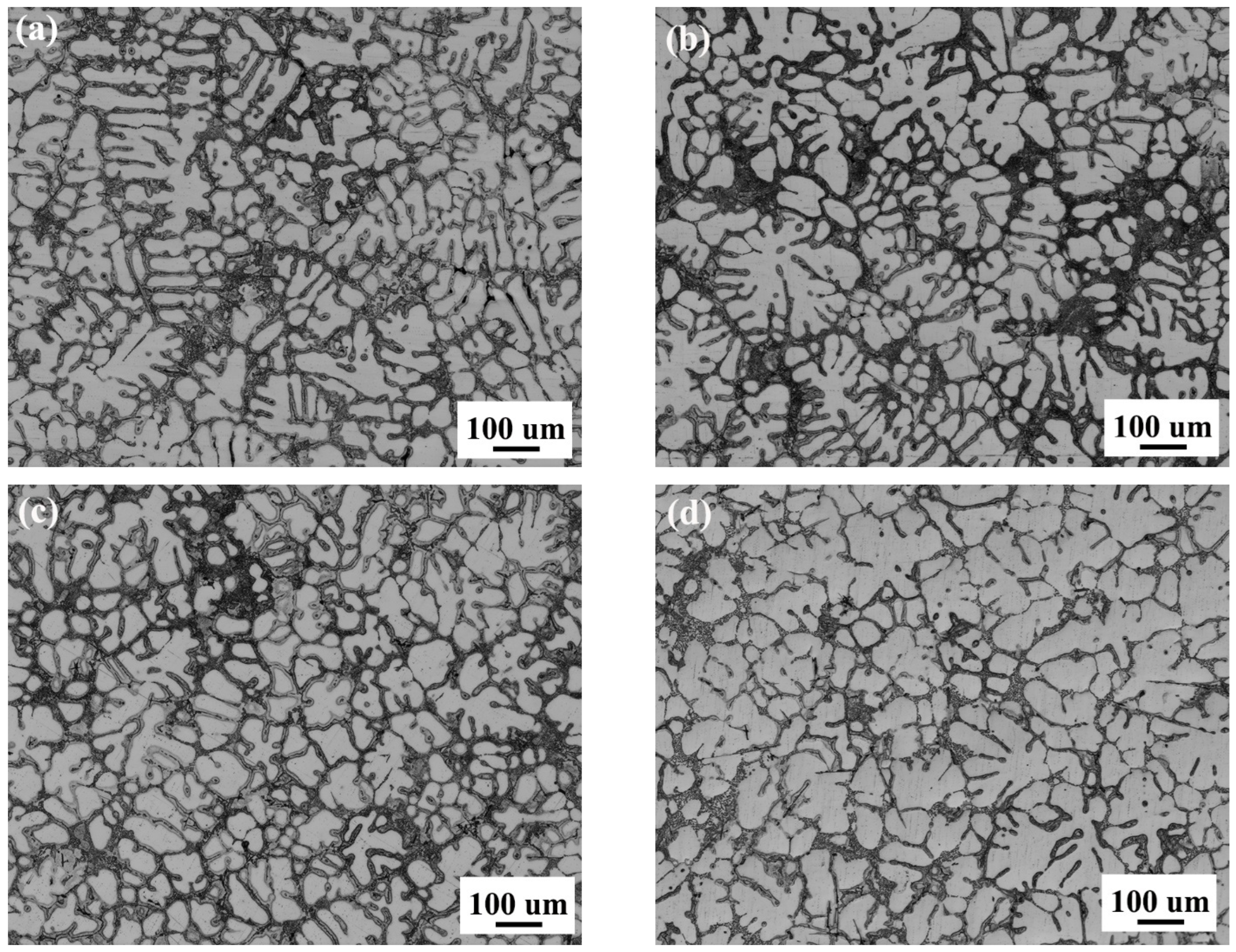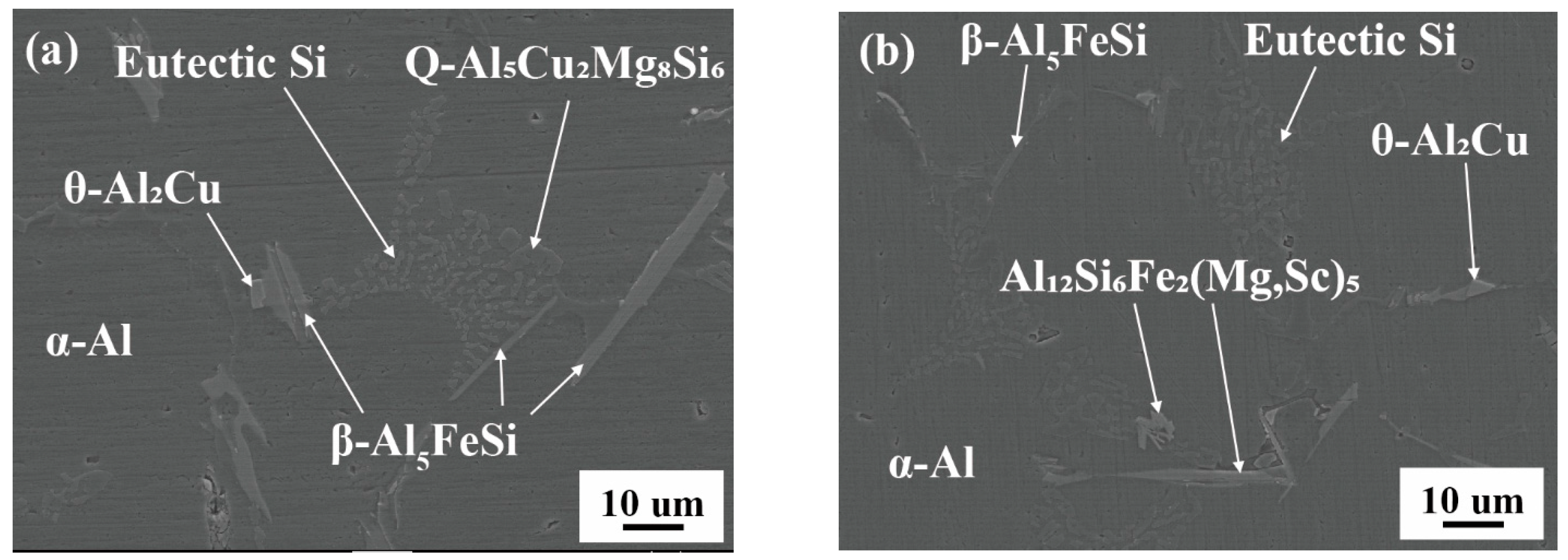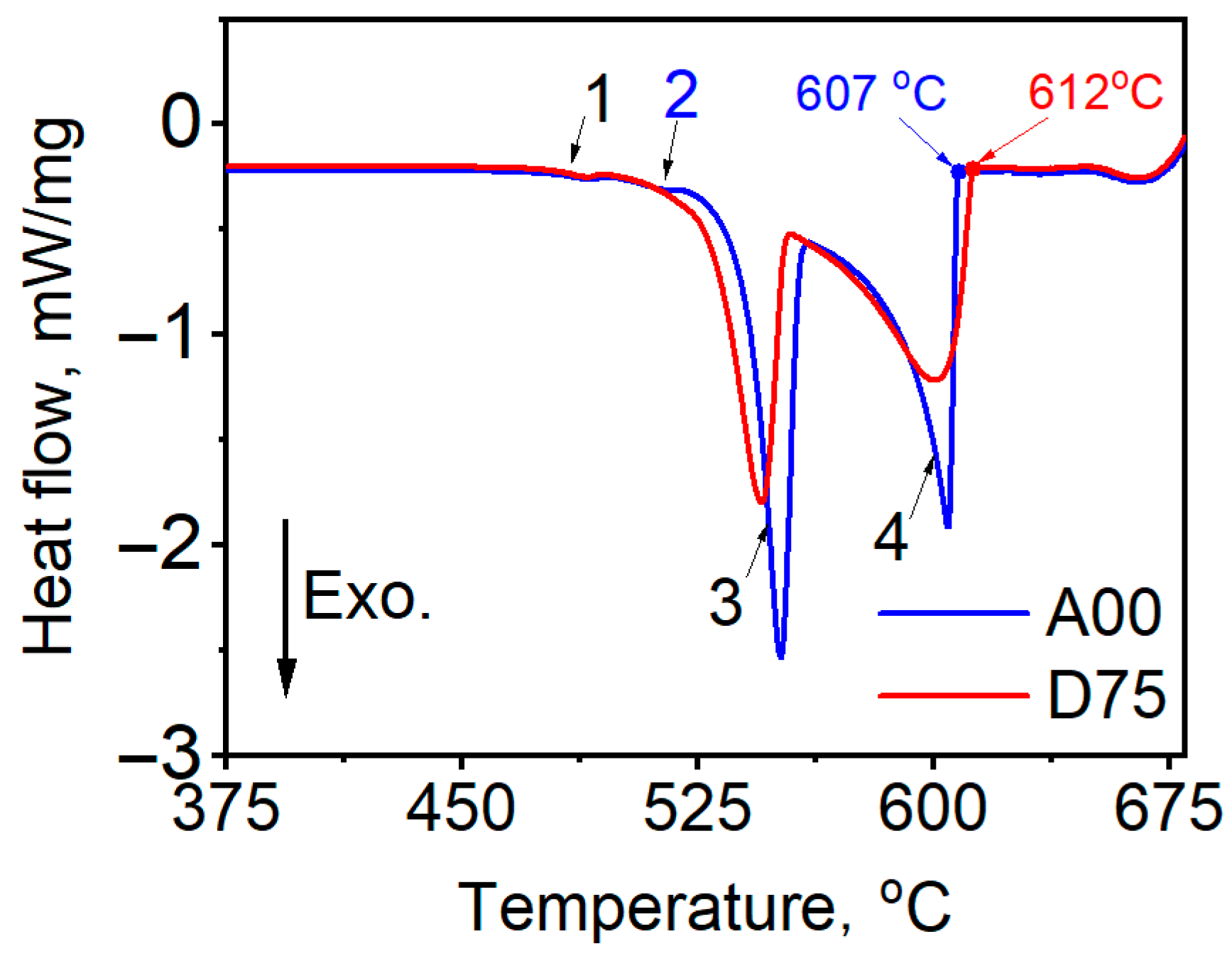Enhancement of Solidification Microstructure and Mechanical Properties of Al-5Si-Cu-Mg Alloy Through the Addition of Scandium and Zirconium
Abstract
1. Introduction
2. Experimental Materials and Methods
2.1. Alloy Composition Design
2.2. Experimental Procedures
2.3. Characterization Methods
2.4. Mechanical Testing
3. Experimental Results
3.1. Microstructures
3.2. Mechanical Properties
4. Discussion
4.1. Evolution of Solidification and Precipitation Microstructures
4.2. Correlation Between Microstructure and Mechanical Behavior
5. Conclusions
- (1)
- The combined addition of scandium (Sc) and zirconium (Zr) effectively refines the α-Al grains and modifies the eutectic Si morphology in Al-5Si-1.2Cu-0.5Mg alloys. The optimal refinement occurs at 0.5 wt.% Sc/Zr, attributed to the formation of coherent Al3(Sc,Zr) dispersoids that promote heterogeneous nucleation and suppress needle-like β-Al5FeSi phases.
- (2)
- Mechanical testing shows that yield strength increases with Sc/Zr content due to grain-boundary and precipitation strengthening, while the base alloy without Sc/Zr maintains superior ductility, likely owing to its finer secondary dendrite arm spacing and absence of casting cracks.
- (3)
- Moderate Sc/Zr additions (0.25–0.5 wt.%) yield optimal mechanical balance, whereas excessive additions (>0.5 wt.%) promote silicide and Fe-rich intermetallic formation, reducing ductility and promoting brittleness. Therefore, controlled Sc/Zr additions below 0.5 wt.% are recommended to achieve an optimal combination of strength, ductility, and microstructural stability.
Author Contributions
Funding
Data Availability Statement
Conflicts of Interest
References
- Zhang, M.; Tian, Y.; Zheng, X.; Zhang, Y.; Chen, L.; Wang, J. Research Progress on Multi-Component Alloying and Heat Treatment of High Strength and Toughness Al–Si–Cu–Mg Cast Aluminum Alloys. Materials 2023, 16, 1065. [Google Scholar] [CrossRef]
- Javidani, M.; Larouche, D.; Grant Chen, X. Assessment of Post-eutectic Reactions in Multicomponent Al-Si Foundry Alloys Containing Cu, Mg, and Fe. Metall. Mater. Trans. A 2015, 46, 2933–2946. [Google Scholar] [CrossRef]
- Murakami, Y.; Furushima, R.; Shiga, K.; Miyajima, T.; Omura, N. Mechanical property prediction of aluminium alloys with varied silicon content using deep learning. Acta Mater. 2025, 286, 120683. [Google Scholar] [CrossRef]
- Liu, W.; Xiao, W.; Xu, C.; Liu, M.; Ma, C. Synergistic effects of Gd and Zr on grain refinement and eutectic Si modification of Al-Si cast alloy. Mater. Sci. Eng. A 2017, 693, 93–100. [Google Scholar] [CrossRef]
- Aguilera-Luna, I.; Castro-Román, M.J.; Escobedo-Bocardo, J.C.; García-Pastor, F.A.; Herrera-Trejo, M. Effect of cooling rate and Mg content on the Al–Si eutectic for Al–Si–Cu–Mg alloys. Mater. Charact. 2014, 95, 211–218. [Google Scholar] [CrossRef]
- Zhu, L.; Zhang, Y.; Luo, Q.; Peng, L.; Li, Q. Effectively refining Al-10Si alloy via Al-Ti-Nb-B refiner with Nb2O5. J. Mater. Sci. Technol. 2024, 176, 204–210. [Google Scholar] [CrossRef]
- Greer, A.L.; Bunn, A.M.; Tronche, A.; Evans, P.V.; Bristow, D.J. Modelling of inoculation of metallic melts: Application to grain refinement of aluminium by Al–Ti–B. Acta Mater. 2000, 48, 2823–2835. [Google Scholar] [CrossRef]
- Farkoosh, A.R.; Grant Chen, X.; Pekguleryuz, M. Interaction between molybdenum and manganese to form effective dispersoids in an Al–Si–Cu–Mg alloy and their influence on creep resistance. Mater. Sci. Eng. A 2015, 627, 127–138. [Google Scholar] [CrossRef]
- Vinod Kumar, G.S.; Murty, B.S.; Chakraborty, M. Development of Al–Ti–C grain refiners and study of their grain refining efficiency on Al and Al–7Si alloy. J. Alloys Compd. 2005, 396, 143–150. [Google Scholar] [CrossRef]
- Hegde, S.; Prabhu, K.N. Modification of eutectic silicon in Al–Si alloys. J. Mater. Sci. 2008, 43, 3009–3027. [Google Scholar] [CrossRef]
- Timpel, M.; Wanderka, N.; Schlesiger, R.; Yamamoto, T.; Lazarev, N.; Isheim, D.; Schmitz, G.; Matsumura, S.; Banhart, J. The role of strontium in modifying aluminium–silicon alloys. Acta Mater. 2012, 60, 3920–3928. [Google Scholar] [CrossRef]
- Callegari, B.; Lima, T.N.; Coelho, R.S. The Influence of Alloying Elements on the Microstructure and Properties of Al-Si-Based Casting Alloys: A Review. Metals 2023, 13, 1174. [Google Scholar] [CrossRef]
- Lei, Z.; Wen, S.; Huang, H.; Wei, W.; Nie, Z. Grain Refinement of Aluminum and Aluminum Alloys by Sc and Zr. Metals 2023, 13, 751. [Google Scholar] [CrossRef]
- Bayraktar, Ş.; Alparslan, C.; Salihoğlu, N.; Sarıkaya, M. The impact of heat treatment process on the drilling characteristics of Al–5Si–1Cu–Mg alloy produced by sand casting. J. Mater. Res. Technol. 2024, 33, 2764–2772. [Google Scholar] [CrossRef]
- Li, Y.; Yang, Y.; Wu, Y.; Wang, L.; Liu, X. Quantitative comparison of three Ni-containing phases to the elevated-temperature properties of Al–Si piston alloys. Mater. Sci. Eng. A 2010, 527, 7132–7137. [Google Scholar] [CrossRef]
- Qin, J.; Tan, P.; Quan, X.; Liu, Z.; Yi, D.; Wang, B. The effect of sc addition on microstructure and mechanical properties of as-cast Zr-containing Al-Cu alloys. J. Alloys Compd. 2022, 909, 164686. [Google Scholar] [CrossRef]
- Li, P.; Li, R.; Yang, H.; Yuan, T.; Niu, P.; Wang, M.; Li, L.; Chen, C. Selective laser melting of Al-3.48Cu-2.03Si-0.48Sc-0.28Zr alloy: Microstructure evolution, properties and metallurgical defects. Intermetallics 2021, 129, 107008. [Google Scholar] [CrossRef]
- Zhang, M.; Wang, J.; Wang, B.; Xue, C.; Liu, X. Improving mechanical properties of Al–Si–Cu–Mg alloys by microallying Sc using thermodynamic calculations. Calphad 2022, 76, 102394. [Google Scholar] [CrossRef]
- Chuvil’deev, V.; Nokhrin, A.; Kozlova, N.; Shadrina, I.; Bobrov, A.; Kopylov, V.; Komel’kov, A.; Morozkina, E. Combined Effect of the Sc/Zr Ratio and Mg Concentration on the Intergranular Corrosion Resistance of Al–Mg–Sc–Zr Alloys: A Case of Cast Alloys and Ultrafine-Grained Alloys. Metals 2025, 15, 372. [Google Scholar] [CrossRef]
- Prukkanon, W.; Srisukhumbowornchai, N.; Limmaneevichitr, C. Influence of Sc modification on the fluidity of an A356 aluminum alloy. J. Alloys Compd. 2009, 487, 453–457. [Google Scholar] [CrossRef]
- Tzeng, Y.-C.; Wu, C.-T.; Bor, H.-Y.; Horng, J.-L.; Tsai, M.-L.; Lee, S.-L. Effects of scandium addition on iron-bearing phases and tensile properties of Al–7Si–0.6Mg alloys. Mater. Sci. Eng. A 2014, 593, 103–110. [Google Scholar] [CrossRef]
- Røyset, J.; Ryum, N. Scandium in aluminium alloys. Int. Mater. Rev. 2005, 50, 19–44. [Google Scholar] [CrossRef]
- Xu, C.; Xiao, W.; Zheng, R.; Hanada, S.; Yamagata, H.; Ma, C. The synergic effects of Sc and Zr on the microstructure and mechanical properties of Al–Si–Mg alloy. Mater. Des. 2015, 88, 485–492. [Google Scholar] [CrossRef]
- Marquis, E.A.; Seidman, D.N. Nanoscale structural evolution of Al3Sc precipitates in Al(Sc) alloys. Acta Mater. 2001, 49, 1909–1919. [Google Scholar] [CrossRef]
- Li, C.; Wu, S.; Lü, S.; Li, J.; Liu, L.; Xia, L. Effects of Excessive Zr Content and Ultrasonic Treatment on Microstructure and Mechanical Properties of Al-Zn-Mg-Cu Alloy. Metals 2021, 11, 632. [Google Scholar] [CrossRef]
- Fuller, C.B.; Seidman, D.N.; Dunand, D.C. Mechanical properties of Al(Sc,Zr) alloys at ambient and elevated temperatures. Acta Mater. 2003, 51, 4803–4814. [Google Scholar] [CrossRef]
- Robson, J.D. A new model for prediction of dispersoid precipitation in aluminium alloys containing zirconium and scandium. Acta Mater. 2004, 52, 1409–1421. [Google Scholar] [CrossRef]
- Srinivasan, D.; Chattopadhyay, K. Metastable phase evolution and hardness of nanocrystalline Al–Si–Zr alloys. Mater. Sci. Eng. A 2001, 304–306, 534–539. [Google Scholar] [CrossRef]
- Hirano, T.; Ohtani, H.; Hasebe, M. Thermodynamic Analysis of the Al-Si-Zr Ternary System. High Temp. Mater. Process. 2010, 29, 347–372. [Google Scholar] [CrossRef]
- Booth-Morrison, C.; Mao, Z.; Diaz, M.; Dunand, D.C.; Wolverton, C.; Seidman, D.N. Role of silicon in accelerating the nucleation of Al3(Sc,Zr) precipitates in dilute Al–Sc–Zr alloys. Acta Mater. 2012, 60, 4740–4752. [Google Scholar] [CrossRef]
- Pandee, P.; Gourlay, C.M.; Belyakov, S.A.; Patakham, U.; Zeng, G.; Limmaneevichitr, C. AlSi2Sc2 intermetallic formation in Al-7Si-0.3Mg-xSc alloys and their effects on as-cast properties. J. Alloys Compd. 2018, 731, 1159–1170. [Google Scholar] [CrossRef]
- Mohamed, A.M.A.; Samuel, E.; Zedan, Y.; Samuel, A.M.; Doty, H.W.; Samuel, F.H. Intermetallics Formation during Solidification of Al-Si-Cu-Mg Cast Alloys. Materials 2022, 15, 1335. [Google Scholar] [CrossRef] [PubMed]
- Samuel, F.H.; Doty, H.; Abdelaziz, M.H.; Samuel, A.M.; Gagnon, D. Melt Treatment-Porosity Formation Relationship in Al-Si Cast Alloys. In Casting Processes and Modelling of Metallic Materials; Abdallah, Z., Aldoumani, N., Eds.; IntechOpen: London, UK, 2021. [Google Scholar]
- Samuel, A.M.; Samuel, E.; Songmene, V.; Samuel, F.H. A Review on Porosity Formation in Aluminum-Based Alloys. Materials 2023, 16, 2047. [Google Scholar] [CrossRef] [PubMed]









| Alloy | Al (bal.) | Si | Cu | Mg | Fe | Sr | Sc | Zr |
|---|---|---|---|---|---|---|---|---|
| A00 | Rem. | 5.16 | 0.82 | 0.40 | 0.42 | 0.02 | <0.01 | <0.01 |
| B25 | Rem. | 5.38 | 0.86 | 0.38 | 0.41 | 0.02 | 0.12 | 0.10 |
| C50 | Rem. | 5.30 | 0.85 | 0.34 | 0.40 | 0.02 | 0.24 | 0.19 |
| D75 | Rem. | 5.86 | 0.96 | 0.42 | 0.44 | 0.02 | 0.40 | 0.26 |
| Phase | Al | Si | Fe | Cu | Mg | Mn | Sc | Zr |
|---|---|---|---|---|---|---|---|---|
| β-Al5FeSi | 42.9–45.2 | 24.8–25.3 | 25.4–27.2 | - | - | 2.9–3.2 | - | - |
| θ-Al2Cu | 40.1–48.5 | 0.8 | - | 50.4–56.7 | - | - | - | - |
| Q-Al5Cu2Mg8Si6 | 27.6 | 66.1 | - | 1.2 | 0.6 | - | - | - |
| Al12Si6Fe2(Mg,Sc)5/Al15(Fe,Mn)3(Si,Zr,Sc)2 | 27.3–36.9 | 22.9–26.6 | 21.1–26.0 | 0−2.0 | 0.8–0.9 | 2.2–3.0 | 4.5–11.5 | 0.6–2.8 |
Disclaimer/Publisher’s Note: The statements, opinions and data contained in all publications are solely those of the individual author(s) and contributor(s) and not of MDPI and/or the editor(s). MDPI and/or the editor(s) disclaim responsibility for any injury to people or property resulting from any ideas, methods, instructions or products referred to in the content. |
© 2025 by the authors. Licensee MDPI, Basel, Switzerland. This article is an open access article distributed under the terms and conditions of the Creative Commons Attribution (CC BY) license (https://creativecommons.org/licenses/by/4.0/).
Share and Cite
Li, T.; Shan, L.; Wang, C.; Wu, J.; Zheng, J.; Wang, K. Enhancement of Solidification Microstructure and Mechanical Properties of Al-5Si-Cu-Mg Alloy Through the Addition of Scandium and Zirconium. Crystals 2025, 15, 981. https://doi.org/10.3390/cryst15110981
Li T, Shan L, Wang C, Wu J, Zheng J, Wang K. Enhancement of Solidification Microstructure and Mechanical Properties of Al-5Si-Cu-Mg Alloy Through the Addition of Scandium and Zirconium. Crystals. 2025; 15(11):981. https://doi.org/10.3390/cryst15110981
Chicago/Turabian StyleLi, Tian, Ling Shan, Chunwei Wang, JinHua Wu, Jianming Zheng, and Kai Wang. 2025. "Enhancement of Solidification Microstructure and Mechanical Properties of Al-5Si-Cu-Mg Alloy Through the Addition of Scandium and Zirconium" Crystals 15, no. 11: 981. https://doi.org/10.3390/cryst15110981
APA StyleLi, T., Shan, L., Wang, C., Wu, J., Zheng, J., & Wang, K. (2025). Enhancement of Solidification Microstructure and Mechanical Properties of Al-5Si-Cu-Mg Alloy Through the Addition of Scandium and Zirconium. Crystals, 15(11), 981. https://doi.org/10.3390/cryst15110981






